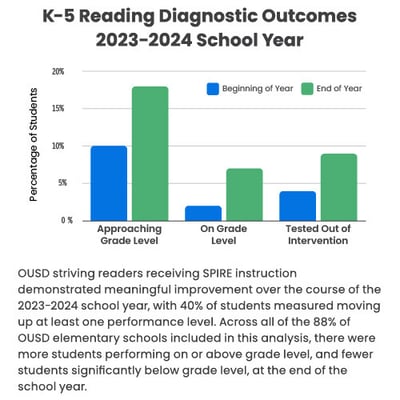Like many school districts nationwide, Oakland Unified School District (OUSD) in California has faced significant staffing challenges—turnover, recruitment, retention, and credentialing—especially in special education and targeted services in other critical areas. Budget cuts and decreased funding, along with declining overall enrollment and an increase in the number of students requiring special education services, provide additional challenges.
Serving more than 34,000 students across 82 schools, with over half of students coming from economically disadvantaged households, OUSD faces challenges familiar to many large school districts around the country. But OUSD is committed to building full-service community schools that address the diverse needs of its students and their families, with a particular emphasis on literacy.
The Need for a Cohesive Literacy Program
Until 2019, OUSD relied on a variety of literacy interventions and programs that lacked coherence. “Teachers were using whatever products and curricula they had and were familiar with—there was no consistency. It just wasn’t working. Our kids weren’t learning how to read,” said Micaela Reinstein, OUSD Director of Special Education—Elementary Schools.
“We needed a solution to expand student access to high quality reading intervention to our students with IEPs across all schools,” said Alli Guilfoil, a former OUSD elementary special education director and current consultant for the district. “California’s dyslexia legislation, AB 1369, had also recently passed and would require just that in the coming years.”
SPIRE is Chosen as the Teacher-Friendly, Student-Centered Solution
“As the OUSD team evaluated options, we decided against partners with more clinical models,” Guilfoil said. “We wanted a program that integrated smoothly into the school day, so we explored SPIRE, the intensive intervention solution from EPS Learning, and received positive feedback from nearby districts like San Francisco Unified. SPIRE stood out as the most multisensory and teacher-friendly option, fitting well into the schedule without disrupting core content, specials, or recess.”
By 2023, OUSD was fully implemented with SPIRE and iSPIRE. The results were so positive that, in the spring of 2024, OUSD piloted EPS Learning’s digital literacy solution, EPS Reading Assistant, to be used in conjunction with SPIRE. The initial rollout included several classrooms, and results were promising. Reading Assistant is an AI-powered tutor that provides students with personalized reading practice and real-time corrective feedback for rapid improvement. Using voice-recognition technology, the program analyzes students’ reading skills as they read aloud. An interactive avatar provides immediate, customized feedback and micro-interventions.
According to Reinstein, teachers in the pilot program found it to be “a light lift for teachers, with a high payoff for students.”
Reading Assistant provides intentional practice of skills that are explicitly taught through SPIRE. Students encounter the fiction and informational passages from SPIRE and receive real-time feedback as they read the passages. The program also includes other stories so students can quickly move beyond the decodable texts included in the SPIRE content.
Reading Assistant works by helping teachers carve out time for “deliberate practice” of foundational reading skills. Such practice includes:
- Texts that meet students where they are and gently challenge them to go further
- Clear instructions and goals aligned to each student
- Feedback, correction, and intervention as students proceed through practice
To best support the student-teacher relationship, EPS knows that teachers need to be able to reach every student, no matter where they are in their literacy journey. By equipping teachers with tailored, tiered instruction, both striving learners and special education students get the specific assessment, intervention, and practice that they need.
After the pilot program, OUSD rolled out Reading Assistant to all K-8 schools in the fall of 2024. “It’s a great intervention tool and fits into how our special education program is structured,” Reinstein added. “One teacher loved it so much that the principal requested it for the whole school.”
Collaboration Yields Outstanding Results
 OUSD striving readers who received SPIRE instruction demonstrated meaningful improvement over the course of the 2023-2024 school year: 40 percent of measured students moved up at least one performance level.
OUSD striving readers who received SPIRE instruction demonstrated meaningful improvement over the course of the 2023-2024 school year: 40 percent of measured students moved up at least one performance level.
One teacher who has seen significant success with SPIRE and EPS Reading Assistant is Anna Treidler, a teacher at OUSD’s Joaquin Miller Elementary School. Treidler teaches a mild-to-moderate self-contained special education class, typically for grades 3–5, but for the fall 2024 semester, her class was made up of just 4th graders. Treidler credits much of her success with Reading Assistant to the support and resources provided by the EPS Learning team. “What’s been most helpful for me is diving into the teacher’s guide and following the steps and instructions. Once you get into the guide, it’s clear and easy to use compared to some other curriculums I’ve worked with.”
Supporting Teachers and Looking Ahead
Treidler’s positive experience with SPIRE and Reading Assistant extends beyond student progress—it’s also about how these tools support her as an educator. “I really appreciate the Quick Checks in SPIRE. The built-in assessments are extremely helpful for gauging student progress,” she said. “They give me solid data, not just observational notes, which helps me confirm whether students are truly grasping the material.”
EPS Learning, driven by a belief in literacy as an essential springboard to lifelong learning and opportunity, was the right fit to help OUSD empower teachers and students. Jennifer Duffy, a customer success specialist with EPS Learning, reflected on the partnership with OUSD, saying, “It’s so heartening to see teachers and admins who really care. They have a lot of challenges in front of them regarding the needs of their students, but I have no doubt they’ll rise to them.”
To continue reading, fill out this short form
